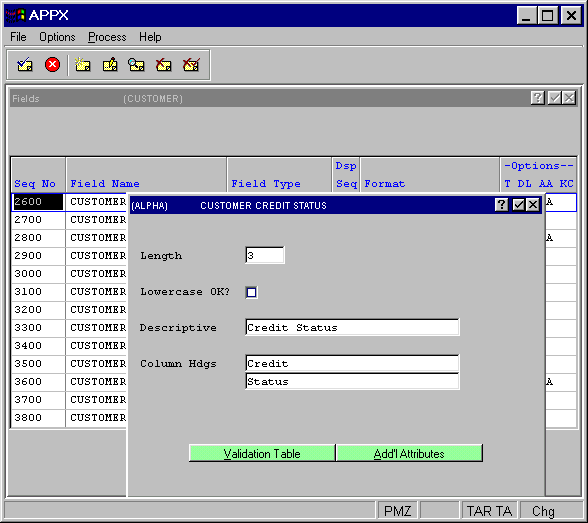
Alpha Fields
An Alpha field can contain numbers, letters, and special characters, such as #, $, and &. Examples include names, addresses, certain account numbers or serial numbers, and text.
The Alpha fields overlay, shown in Figure 2-4-18, allows you to add Alpha specific attributes to those already defined for fields. The alpha field overlay displays after you complete the entries on the Fields specifications screen if the Field Type you select is ALPHA.

Figure 2-4-18. Alpha Fields Overlay
The Alpha Fields overlay contains the following fields:
· Length designates the number of character positions, or length,
of this field up to 32,767 (32K) characters.
Note: APPX does not support fields (or records) longer than 32K characters.
If you map an APPX file to a pre-existing RDBMS table, you may find that
the table includes a column larger than 32K; such columns are often referred
to as memo columns. APPX offers limited support for memo columns. You
can access a memo column by defining (in the APPX data dictionary) an
ALPHA X(n) field in the corresponding position.
When you read a record that includes a memo column, APPX will only read
the first n characters and will truncate any remaining data.
If you read a record with hold and APPX would have to truncate
a memo field, the read will fail. Reading a record with hold implies
that you may try to update the record and APPX will try to prevent you
from losing data through truncation. If you need to delete a record that
would include truncated data, use partial-record I/O to avoid truncation.
You can also use partial-record I/O to update other fields in the
record. In general, you should avoid reading memo columns except in those
cases where you actually need the data.
· Lowercase OK? indicates whether or not a modifiable item
on an interactive screen can be entered in upper- and lowercase letters.
If ‘no” ![]() , the entry is stored and displayed exclusively
as uppercase, regardless of how a user enters the information. This entry
does not affect statements. A lowercase value established with a statement
displays as lowercase, even if this specification prohibits lowercase
entries.
, the entry is stored and displayed exclusively
as uppercase, regardless of how a user enters the information. This entry
does not affect statements. A lowercase value established with a statement
displays as lowercase, even if this specification prohibits lowercase
entries.
· Descriptive provides a longer, more easily understood alternative to Field Name, one that is not required to be unique within an application. If blank at all default levels, Field Name is used. Refer to the definition of Descriptive in the Common Domain Specifications section of Chapter 2-3 for more information.
· Column Hdgs designates up to two lines of column heading text. The APPX output process facility uses this text to generate standard column heading images for Start of Page and Start of Range class frames. For cosmetic reasons, the length of headings should not exceed the length of a field itself. Refer to Standard Column Heading Image for additional information.
The Alpha Fields overlay provides two options which are described in the corresponding sections: